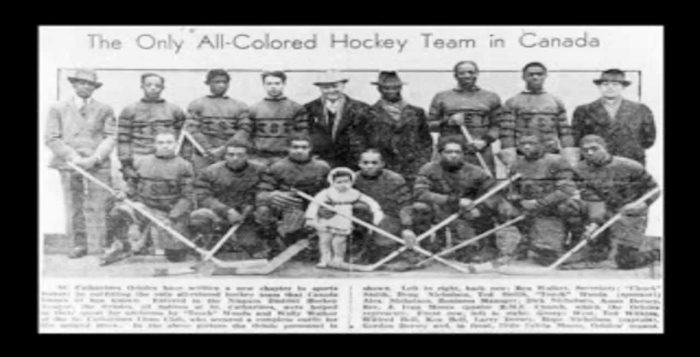This Day in Hockey History – February 27, 1895 – Black Ice at Dartmouth Curling Rink
Before the NHL of 1917, the National Hockey Association (NHA) of 1909, and even the Canadian Amateur Hockey League (CAHL) of 1898, Nova Scotians began a Coloured Hockey League (CHL). Like many hockey origin stories, its beginnings remain murky with only scattered newspaper articles helping to piece together the timeline. As best as brothers George and Darril Fosty, authors of Black Ice, have determined, the first recorded game of the CHL was played on February 27, 1895.
The CHL was organized by Baptist leaders in Nova Scotia as a way to generate employment opportunities and income in Halifax’s black community. In doing so, the goal was also to raise black awareness and pride. Henry Sylvester Williams (father of the Pan-African movement) helped lay the groundwork and then promoted the first organized black hockey clubs, the Dartmouth Jubilees, the Halifax Eurekas, and the Halifax Stanley. Many of the players for these teams came from all-black baseball teams.
Rather than setting a schedule, one team would invite another to a game, often printing the challenge in the local newspaper. Many spectators would come out for the game, including enthusiastic ladies and eventually many white neighbors. Typically, the CHL could only play outdoors or indoors after the ice was so terrible the white teams had finished their own season. In the beginning, “all sorts of skates were worn,” but eventually, the CHL teams had better equipment and standardized uniforms. After the games, the home team would host the visitors for dinner.
The game on February 27, 1895 was hosted by the Dartmouth Curling Rink, where evangelists often met. The players also were Baptists, but the style of play was described as “extremely rough and physical” with “body checking” and “cross counters.” The Halifax Eurekas and Dartmouth Jubilees tied at 1-1.
Also at the end of February 1895, the Jubilees took on the Halifax Stanley, who won 3-1. Their rematch in March also took place at the Dartmouth Curling Rink, where they used curling stones to mark the goal posts. Despite protests by the Jubilees’ goalie, the Stanley scored first and then again before forward Charles Flint got the Jubilees on the board. A follow-up Jubilee goal was disallowed leading to an argument lasting until the first half ended. Throughout the second half, every goal was protested. The Jubilees scored twice, and then Stanley scored right at the end “with an all out fight on the ice.” Ignoring the disallowed goals, both teams claimed a 4-3 victory, but the official score was 3-3. The game was described as “one of the most exciting and amazing matches of the season” watched by ladies who “shouted and danced and expressed their joy.” Although the Jubilees asked for another rematch, the Stanley declined.
At the time, the league suffered from racist coverage by the newspapers. That March, the Acadian Recorder printed an open letter penned by an anonymous black Halifax resident, who chastised the Halifax Herald for its coverage of a game. He wrote, “Such trashy articles have a very deteriorating tendency of elevating the race in no well-thinking citizen can endorse. Thanking you for the space for this vindication of a simple game of hockey played by two colored teams.” Between 1899 and 1904, because the press printed more articles and in less-racist terms, the CHL experienced the height of its popularity and acceptance. Despite the press then swinging back the other way and even intentionally ignoring the CHL, the league continued into the 1930s.
The black Maritime Canadians who played in the CHL left a legacy that lingers in the game as it is played today. The origins of the slapshot and goalies who drop to the ice can be traced back to these players, who followed Halifax rules rather than adhering to the established Montreal set.
Sources:
- George and Darril Fosty, Black Ice: The Lost History of the Colored Hockey League of the Maritimes, 1895-1925 (Nimbus Pub., 2008), kindle version.
- Sheldon Gillis, “Putting it on Ice: A Social History of Hockey in the Maritimes, 1880-1914,” thesis for Saint Mary’s University, Halifax, N.S., 1994, pp. 72-96.
- https://en.wikipedia.org/wiki/Coloured_Hockey_League
- https://www.thecanadianencyclopedia.ca/en/article/coloured-hockey-league














